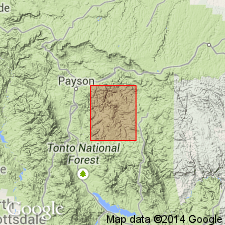
- Usage in publication:
-
- Houden formation
- Modifications:
-
- Original reference
- Dominant lithology:
-
- Quartzite
- Conglomerate
- AAPG geologic province:
-
- Basin-and-Range province
Summary:
Pg. 1498 (table 1), 1501-1502, pl. 1. Houden formation. Can generally be subdivided into three or four members: basal gravel conglomerate 40 to 100 feet thick, lower part of which is cross-laminated in beds 3 to 8 inches thick, upper part vitreous, faintly bluish or greenish; middle member distinguished by gray, purple, or brick-red, predominantly fine-grained quartzite in lower part and slate and graded wacke in upper part, thickest section 380 feet on Houden Mountain; and upper quartzite 390 to 420 feet thick divisible into three submembers in Board Cabin Draw. Unconformably overlies Flying W formation (new); conformably underlies Board Cabin formation (new). Age is Precambrian.
Type section: on southwestern corner of Colcord Mesa and begins on boundary of section 18, 0.25 mi west of elevation marker 5687, from which it extended N. 25 deg. W. for approx. 0.5 mi, or to elevation marker 5651. Other good sections on Board Cabin, Houden Mountain, and Spring Creek opposite Buzzard Roost Mesa. Named from Houden Mountain in south-central part of Diamond Butte quadrangle, east-central AZ.
Source: US geologic names lexicon (USGS Bull. 1200, p. 1817).
For more information, please contact Nancy Stamm, Geologic Names Committee Secretary.
Asterisk (*) indicates published by U.S. Geological Survey authors.
"No current usage" (†) implies that a name has been abandoned or has fallen into disuse. Former usage and, if known, replacement name given in parentheses ( ).
Slash (/) indicates name conflicts with nomenclatural guidelines (CSN, 1933; ACSN, 1961, 1970; NACSN, 1983, 2005, 2021). May be explained within brackets ([ ]).

